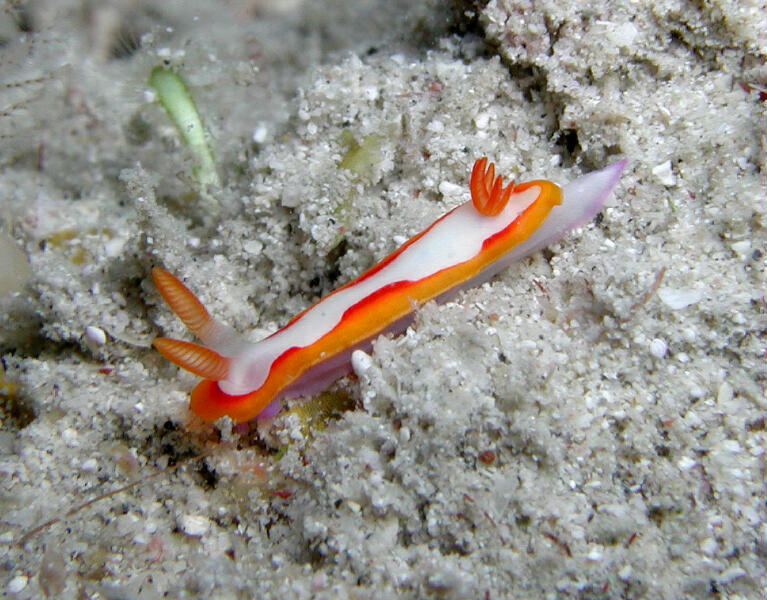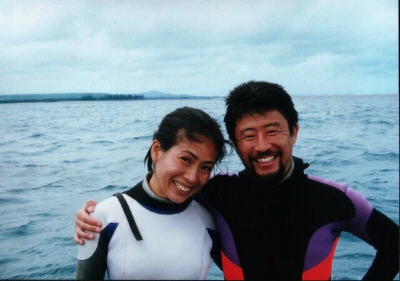 |
Thorunna purpuropedis
Photo courtesy of Nishina MasayoshiZamami Island, Okinawa
May, 2002
I can't tell you how excited I get when I see some of the photos coming from our Japanese opisthobranching buddies. Nishina Masayoshi's shot here (aka Masa for short) is exactly what I'm talking about. What a beautiful shot of a beautiful creature.
This is Thorunna purpuropedis , a species whose identification is easily confused with Thorunna montrouzieri and even Thorunna speciosus . See Bill Rudman's Sea Slug Forum for a discussion of this.). Rudman distinguishes Thorunna purpuropedis from the others by the orange border which is continuous around the entire mantle. The smart red high-light inside this orange band gives striking appearance next to the pure white central dorsum. Wow !
Thorunna purpuropedis was originally described from Enewetak Atoll in the Marshall Island's, where it was first collected by buddy Scott Johnson. The name,"purpuropedis" denotes the purple color of the foot, as seen here in Masa's photo. This specimen is approximately 10 mm in length and was taken in 25 feet of water at Zamami Island , Kerama, Okinawa. I believe that this observation clearly establishes the geographic distribution of this species to include Japan and Okinawa.
We will be hearing more about the creatures of Okinawa from Masa and Webmaster Miller in the next couple of weeks.
Danville, Calif
Jun., 2002

|
I and my wife Chikako love branchs, it's may be just because branchs are beautiful, cute, mysterious animal. And even a branchs always seen has new discovery. These are the charms which will never release us. When we became interested in branchs in the early of the 90's, We're not able to know in detail about branchs and even the name of it in Japan and we had no one to talk. In the late 90's, we found Bill Rudman's slug site , Mike's site, B.Picton's site and so on. Those were amazing and we're shocked because learning is progressing there. Soon those made us crazy about branchs. Thanks to spread of the Internet, I could exchange knowledge with foreign researchers, I could know Atsushi Ono and Rie Nakano(who is the editor of Ono's book). Meanwhile, We'd a chance to go to Hachijo Island(290K south of Tokyo). Luckily we could meet a best sea slug guide named Kotaro Tanaka who is now an owner of dive operator named "CON:COLOR" there. Since then we are sea slug observers ofbranchs speciality now.
|
Yokohama, Japan
June, 2002
Send Masa email at nishina@wips.co.jp
Webmaster's Note : For those who don't realize it, Masa's image was taken with a digital camera! Here is an image of the same animal taken at aprox. 1:1 with a Nikon F3 film based camera. Comparing the two one is immediately aware of the increased magnification and clarity in the digital image probably somewhere in the range of 2:1 to 3:1. This is very difficult to do with film based cameras without special equipment.. As additional background on this scenario, Jerry Allen and I ( with the exception of our dive guide Ono-san) were the only divers out of five using a film based camera. Anyhow I asked Masa how he and his wife came to embrace the digital camera as the way to photograph branchs, and this is his reply;
"....This is a story why I stared to use digital camera.
I had a Cannon EOS10+housing+90mm Macro lens before when I interested in ordinal size macro creature. but since I became brancher, this equipment is not good enough for sea slug less then 30mm and I was planing to get 100mm macro lens with telecon and so on but for several reason I didn't. because, "until it is developed, I don't know a result condition of photo, and it takes much money for development. Those kind of camera is heavy and take much time to set up before go to dive. So I do not get any options and didn't take the camera for many years. I am a quite lazy man!
So I was always asking to somebody to photograph of sea slug. Sometimes they do but sometimes they don't. because, of course, those friends has something else which their want to take. I started to feel sorry to miss to take photos of those precious record of sea slugs.
Meanwhile, The performance of digital camera became practical and reasonable price. So I tried to use Olympus Z3030+ Olympus's ready made UW housing. That was easy to handle and good enough for a small sea slug like a Chromodoris. Liquid crystal viewer is easy to see when I use the close up function. The photographic subject depth is deep so it was enough camera for 30-50mm sea slug.
A year later, my wife started to use digital camera Nikon Coolpix880+INON UW housing.
I was surprised on the performance of the camera when she used it on first day. She
could take a photo of 10mm sea slug easily without any option lens, function, and
she never use UW camera before. It was big shock for me. I couldn't take that much
small slug with my Olympus. That time, I wanted to photograph further more small
sea slug like 5mm Saco. So needless to say, soon I have got it too. Although, laptop
PC is necessary to storage those image files when we go to diving trip and need a kind
of image viewer and so on, digital camera is still reasonable. Anyway we can confirn
what we saw in today's diving soon after we exit from sea.
There's a message here folks!
Jerry and I throughly enjoyed the Kerama Islands trip and Masa was instrumental in making it a success with his ability to translate. We are of course also heavily in debt to Rie Nakano who set the trip up in the first place and Atsushi Ono who introduced (found) most of the branchs that will be featured on the Slug Site in weeks to come. No Okinawa trip is complete without visiting with or diving with Bob Bolland, the Webmaster of the Okinawa Slug Site . Bob was gracious enough to pick us up at the airport and show us around. Bob even picked up some additional dive gear for me when I lost a fin in the Keramas. Yes, I know it sounds weird but it happened! We are truly also in debt to Bob and would like to repay the kindness someday if we could somehow entice him off the "rock."
We definitely plan to go back!
Webmaster
The Slug Site
Taxonomic information courtesy of:

David W. Behrens
Author:
Pacific Coast Nudibranchs
Send Dave mail at seachalleng@earthlink.net
|
